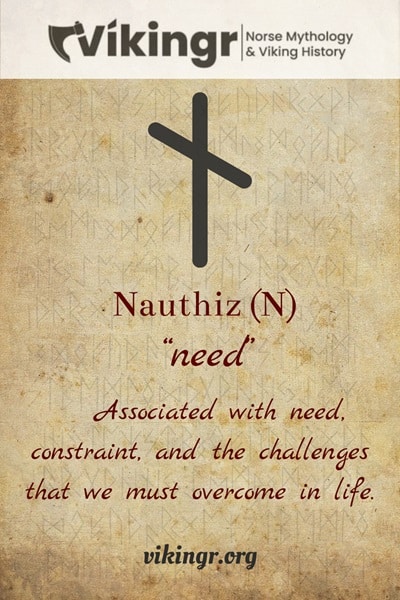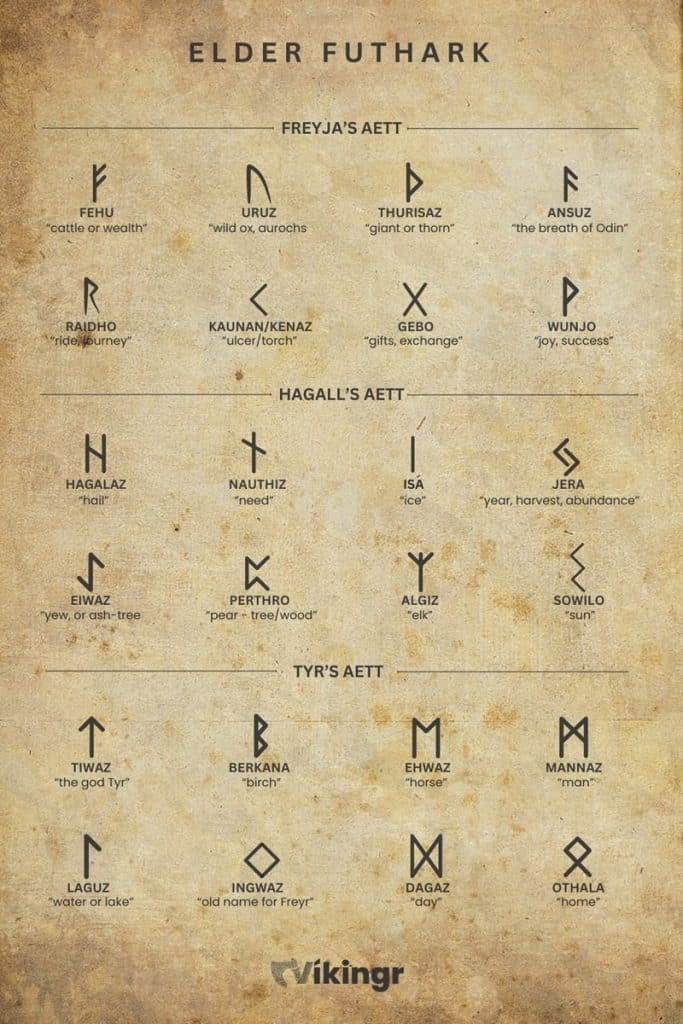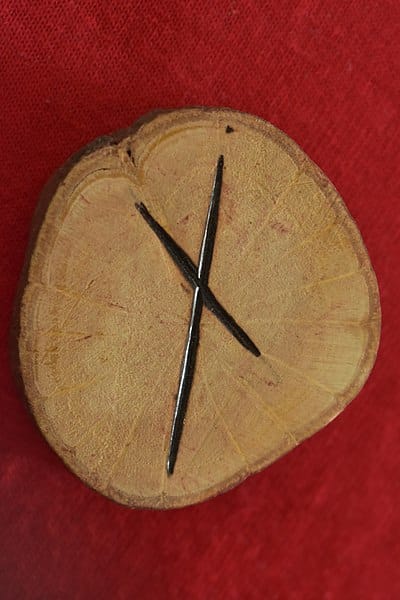In this post, I will explore the Elder Futhark rune Nauthiz and its symbolism. Nauthiz is the second rune, in the second aett of the Elder Futhark. Also known as the Naudiz rune, it is a symbol of need, constraint and necessity.
Nauthiz Background and Description
Let’s start at the beginning, with the Elder Futhark, the oldest form of the runic alphabets. The Elder Futhark is divided into three aetts of eight runes each. Nauthiz is the second rune in the second aett, which is associated with the guardian god Heimdall. It follows the rune Hagalaz and precedes Isa. The name “Nauthiz” comes from Old Norse, translating roughly to “need” or “necessity.”
People used the Elder Futhark across Europe, reaching from Scandinavia to the British Isles, and extending as far south as Italy. Researchers have discovered etchings on a variety of items, ranging from monumental runestones to simple everyday objects.
The etymology of “Nauthiz”, or “Naudiz” is intriguing. Rooted in the Proto-Germanic “*nauþiz,” it’s associated with need, hardship, and constraint. This gives us a glimpse into the mindset of the ancient Germanic peoples, showing us that they recognized the role of hardship and necessity in life.

Graphical Representation
Visually, Nauthiz is a simple yet powerful rune. It’s composed of one vertical line, crossed by a shorter line around the middle, slightly at an angle down towards the right.
Historically, variations of Nauthiz’s design have been found. Some inscriptions show the rune with more curved lines or with the lines intersecting at different points. However, the traditional form remains the most recognized and used.
Phonetic Value
In the Proto-Germanic language, Nauthiz represented the sound “n,” as in “need.” As Germanic languages evolved, so did the pronunciation of this rune. In Old Norse, for example, it was pronounced as a hard “n.”
Symbolic Meaning of the Nauthiz Rune
Now, let’s delve into the symbolic heart of Nauthiz. This rune is traditionally associated with need, hardship, and constraint. It represents the challenges and necessities of life, reminding us that hardship is often a catalyst for growth and transformation.
The rune is also linked to resilience and the human capacity to overcome difficulties. It’s a reminder of the strength and determination that lie within us, even in the face of adversity.

The Watchman of the Gods, Heimdall, is a central figure in Norse mythology, embodying vigilance, resilience, and the protective power of foresight. Nauthiz, with its associations with need and resilience, reflects these themes, offering a glimpse into the values and beliefs of the ancient Germanic peoples.
The Aett and its Symbolism
Nauthiz belongs to the second aett of the Elder Futhark, a group of eight runes associated with the god Heimdall. This aett, or family of runes, carries themes of resilience, transformation, and the cyclical nature of life.
Moreover, Heimdall, the Watchman of the Gods, is a central figure in this aett. Known for his vigilance and foresight, Heimdall embodies the protective and resilient energies that are reflected in the runes of his aett. Consequently, Nauthiz, with its associations with need and resilience, reflects these themes, offering a glimpse into the values and beliefs of the ancient Germanic peoples.
In addition, the second aett, where Nauthiz finds its place, is a journey of self-discovery and transformation. It’s about facing challenges head-on, learning from them, and emerging stronger. With its symbolism of need and necessity, the rune plays a crucial role in this journey. Lastly, it’s a reminder that sometimes, it’s through our greatest needs and challenges that we find our greatest strengths.

Elder Futhark Quiz
Do you want to test your knowledge of the Elder Futhark runes? Then this quiz is perfect for you! Try this fun way to get to know the Elder Futhark and its twenty four runes.
Don’t forget to play our other games as well!
Nauthiz Used in Divination and Magic

Now, I must preface this section by saying that while I don’t personally believe in divination or magic, this is a popular topic and I have looked into it. So, let’s explore how Nauthiz is interpreted in these contexts.
In runic divination, Nauthiz often signifies a time of need or hardship. It’s a call to tap into our inner strength and resilience, to face our challenges head-on. It’s not necessarily a negative sign, but rather a reminder that through struggle, we often find growth and transformation.
The ancient Germanic peoples actively used Nauthiz in magic and spellwork. They held a belief that this rune had the power to conquer difficulties and satisfy needs. For instance, they believed that inscribing a spell with this rune would enable the spellcaster to surmount a challenging situation or attain a specific goal.
In the modern era, these interpretations actively shape the use of Nauthiz in neo-pagan practices. Whether in divination or spellwork, it stands as a potent symbol of resilience, transformation, and the human ability to triumph over adversity.
Frequently Asked Questions
Nauthiz represents need, hardship, and constraint. It’s a symbol of resilience and the human capacity to overcome difficulties.
In divination, Nauthiz often signifies a time of need or hardship. It’s a call to tap into inner strength and resilience.
Yes, people historically used Nauthiz actively in magic and spellwork, believing it could help them conquer difficulties and satisfy needs.
Featured Image Credit: BK, Public domain, via Wikimedia Commons

I have an interesting story about this rune. So I was raised Christian, but I got side tracked into some new age type stuff and learned a technique for opening chakras. I was too young and suffered from lots of trauma, abuse, and neglect from my parents (one believing they were devout Christian and the other atheist, divorced and fighting endlessly). Not knowing what I was getting myself into, I tried this technique out and awakened my first 2 chakras and decided to stop, because I realized I wasn’t ready or sure about what I was doing. It was an incredible experience and that night I had the most vivid dream I’ve ever had, filled with symbolism of my life and future (I believed anyway).
Near the end of the dream, I was looking in a mirror and saw many symbols that seemed painted on my chest, and a small license plate glued above them as well. This I knew in the dream to be my future and I began with using soapy water to remove the plate from my chest. Near the plate was this rune above all the others and much larger as well. It was tattooed or painted on thickly; pronounced and the only one I remembered. The following day, I told my younger brother who introduced me to this spiritual stuff some time before. He grabbed a book on runes and opened it, and it happened to open right to the page describing this rune.
The description read like this: “One who is marked with this rune is cursed by the gods. The individual will believe where is hope and grow stronger with not giving up and overcoming the trials, but will forever be cursed with no way out…” or something like that. I wrestled with that for a while, with my young, inexperienced and, poorly guided mind believing that the description and the way it played out bared enough truth to take seriously. It led to me giving up and terrible things befalling me. I was saved by Christ’s teachings and more later came along and I started to believe in this curse again.
I recently returned to Christ’s teachings and decided to look up this rune online and find a very different and positive interpretation that far better resonates with my life. I have felt a tightness around my fire chakra (3rd chakra where I stopped; don’t know if that’s related) and I’ve noticed today that it feels like my fire has been bottled up and turned against me. I’ve been very driven for years to force relaxation on myself to avoid the intensity of my spirit and the demons that rage in me when my spirit gets awakened. I think believing that bad interpretation has turned my spirit against myself, or a demon was created in me to follow the belief in my mind that I was cursed, when I was actually being forged into something better by The Maker.
When I look back at how much pain the lies I’ve been told about me has done to me, I can hardly fathom it. It’s overwhelming to me. Belief I’ve learned from experience, affects our aim and our intentions (same thing really) and I remember that a past trauma from my father laid the foundation for the painful belief of that misinterpretation to take root, and ultimately hurt my faith in The Maker and The Lord.
I hope you find this story helpful and meaningful. Thank you for this explanation. It mark a turning point in my journey for sure.
Hello Lance, really appreciate you being open and vulnerable about your own experience.Thank you for finding this post useful and for sharing your own unique perspective.
My wife does a rune-pull every morning. Lately, we have Nauthiz showing up frequently. It’s good to understand it better.
Hi Rodulf, appreciate your feedback. Fascinated by your wife’s insight and ritual, currently diving more into it.